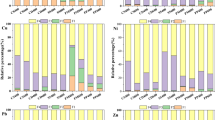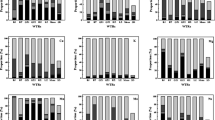Abstract
The aim of this study was to characterize the leachate derived from biochar produced from malt spent rootlets (MSR) and to evaluate the required washing level in order to provide water free from inorganic substances. MSR biochar was placed in a column and subjected to six serial washes with distilled water, and the leachate was analysed for main anions and heavy metals. The 1st wash aliquot contained increased levels of mainly phosphates (980 mg/L) and chlorides (760 mg/L), and lower levels of nitrates, sulfates, fluoride and bromide, which were decreased over washes. Zero concentrations were observed after three washes for most anions. The increased levels of Zn, Be, Cs, Mn, V and Se determined in the 1st wash aliquot were eliminated in the successive washes. The toxic potency of each wash aliquot, determined by the use of the fairy shrimp Thamnocephalus platyurus showed that the 1st and 2nd MSR biochar leachates were toxic with 4.52 and 1.46 toxic units (TU), respectively, followed by a significant elimination of toxicity after further washes.



Similar content being viewed by others
References
Amaral C, Lucas MS, Coutinho J, Cresp AL, do Rosario AM, Pais C (2008) Microbiological and physicochemical characterization of olive mill wastewaters from a continuous olive mill in Northeastern Portugal. Bioresour Technol 99:7215–7223. https://doi.org/10.1016/j.biortech.2007.12.058
Basu P (2010) Biomass gasification and pyrolysis: practical design and theory. Academic Press, Elsevier Inc., Cambridge, Amsterdam
Boni MR, Chiavola A, Marzeddu S (2018) Application of biochar to the remediation of Pb-contaminated solutions. Sustainability 10:4440. https://doi.org/10.3390/su10124440
Boutsika LG, Karapanagioti HK, Manariotis ID (2014) Aqueous mercury sorption by biochar from malt spent rootlets. Water Air Soil Pollut 225:1805. https://doi.org/10.1007/s11270-013-1805-9
Boutsika LG, Karapanagioti HK, Manariotis ID (2017) Effect of chloride and nitrate salts on Hg(II) sorption by raw and pyrolyzed malt spent rootlets: Effect of salts on Hg(II) sorption by malt spent rootlets and their biochar. J Chem Technol Biotechnol 92:1912–1918. https://doi.org/10.1002/jctb.5215
Charalampous N, Kindou A, Vlastos D, Tsarpali V, Antonopoulou M, Konstantinou I, Dailianis S (2015) A multidisciplinary assessment of river surface water quality in areas heavily influenced by human activities. Arch Environ Contam Toxicol 69:208–222
Creasel D (1995) THAMNOTOXKIT FTM. Crustacean toxicity screening test for freshwater. Standard Operational Procedure, Deinze
De Figueredo NA, da Costa LM, Melo LCA, Siebeneichlerd A, Tronto J (2017) Characterization of biochars from different sources and evaluation of release of nutrients and contaminants. Rev Cienc Agron 48(3):395–403
Domene X, Enders A, Hanley K, Lehmann J (2015) Ecotoxicological characterization of biochars: role of feedstock and pyrolysis temperature. Sci Total Environ 512–513:552–561. https://doi.org/10.1016/j.scitotenv.2014.12.035
Genethliou C, Dailianis S, Kornaros M (2020) Biodegradation of olive mill wastewater phenolic compounds in a thermophilic anaerobic upflow packed bed reactor and assessment of their toxicity in digester effluents. J Environ Manage 255:109882
Guo W, Ai Y, Men B, Wang S (2017) Adsorption of phenanthrene and pyrene by biochar produced from the excess sludge: experimental studies and theoretical analysis. Int J Environ Sci Technol 14:1889–1896. https://doi.org/10.1007/s13762-017-1272-8
Gurwick NP, Moore LA, Kelly C, Elias P (2013) A systematic review of biochar research, with a focus on its stability in situ and its promise as a climate mitigation strategy. PLoS ONE 8:e75932. https://doi.org/10.1371/journal.pone.0075932
Hale SE, Lehmann J, Rutherford D, Zimmerman AR, Bachmann RT, Shitumbanuma V, O’Toole A, Sundqvist KL, Arp HPH, Cornelissen G (2012) Quantifying the total and bioavailable polycyclic aromatic hydrocarbons and dioxins in biochars. Environ Sci Technol 46:2830–2838. https://doi.org/10.1021/es203984k
Hwang IH, Ouchi Y, Matsuto T (2007) Characteristics of leachate from pyrolysis residue of sewage sludge. Chemosphere 68:1913–1919. https://doi.org/10.1016/j.chemosphere.2007.02.060
International Organization for Standardization (ISO) 14380 (2011) Water quality - Determination of the acute toxicity to Thamnocephalus platyurus (Crustacea, Anostraca). https://www.iso.org/obp/ui/#iso:std:iso:14380:ed-1:v1:en
Isidori M, Parrella A, Piazza CML, Strada R (2000) Toxicity screening of surface waters in southern Italy with Toxkit microbiotests. In: Persoone G et al (eds) New microbiotests for routine toxicity screening and biomonitoring. Kluwer Academic, New York, pp 289–294
Katranitsas A, Castritsi-Catharios J, Persoone G (2003) The effects of copper based antifouling paint on mortality and enzymatic activity of non-target marine organisms. Mar Pollut Bull 46:1491–1494
Kistler RC, Widmer F, Brunner PH (1987) Behavior of chromium, nickel, copper, zinc, cadmium, mercury, and lead during the pyrolysis of sewage sludge. Environ Sci Technol 21:704–708. https://doi.org/10.1021/es00161a012
Kołtowski M, Oleszczuk P (2015) Toxicity of biochars after polycyclic aromatic hydrocarbons removal by thermal treatment. Ecol Eng 75:79–85. https://doi.org/10.1016/j.ecoleng.2014.11.004
Lehmann J, Joseph S (2009) Biochar for environnemental management. Science and technology. Biochar for environmental management: an introduction. Earthscan, Sterling, London, pp 1–12
Lu H, Zhang W, Yang Y, Huang X, Wang S, Qiu R (2012) Relative distribution of Pb2+ sorption mechanisms by sludge-derived biochar. Water Res 46:854–862. https://doi.org/10.1016/j.watres.2011.11.058
Lyu H, He Y, Tang J, Hecker M, Liu Q, Jones PD, Codling G, Giesy JP (2016) Effect of pyrolysis temperature on potential toxicity of biochar if applied to the environment. Environ Pollut 218:1–7. https://doi.org/10.1016/j.envpol.2016.08.014
Manariotis ID, Fotopoulou KN, Karapanagioti HK (2015) Preparation and characterization of biochar sorbents produced from malt spent rootlets. Ind Eng Chem Res 54:9577–9584. https://doi.org/10.1021/acs.iecr.5b02698
Mason WP (1916) Water supply: considered principally from a sanitary standpoint. Wiley, New York
Michniewicz M, Nałęcz-Jawecki G, Stufca-Olczyk J, Sawicki J (2000) Comparison of chemical composition and toxicity of wastewaters from pulp industry. In: Persoone G et al (eds) New microbiotests for routine toxicity screening and biomonitoring. Kluwer Academic, New York, pp 401–412
Oleszczuk P, Jośko I, Kuśmierz M (2013) Biochar properties regarding to contaminants content and ecotoxicological assessment. J Hazard Mater 260:375–382. https://doi.org/10.1016/j.jhazmat.2013.05.044
Pantiora D, Karapanagioti HK, Manariotis ID, Lycourghiotis A, Kordulis Ch (2014) Evaluation of malt spent rootlets biochar as catalyst for biodiesel production. Geophys Res Abstracts 16:EGU2014-E6508
Papadopoulos KP, Argyriou R, Economou CN, Charalampous N, Dailianis S, Tatoulis TI, Tekerlekopoulou AG, Vayenas DV (2019) Treatment of printing ink wastewater using electrocoagulation. J Environ Manage 237:442–448
Persoone G, Janssen C, De Coen W (2000) New microbiotests for routine toxicity screening and biomonitoring. Kluwer Academic, London
Rehman RA, Rizwan M, Qayyum MF, Ali S, Zia-ur-Rehman M, Zafar-ul-Hye M, Hafeez F, Iqbal MF (2018) Efficiency of various sewage sludges and their biochars in improving selected soil properties and growth of wheat (Triticum aestivum). J Environ Manage 223:607–613. https://doi.org/10.1016/j.jenvman.2018.06.081
Shackley S, Carter S, Knowles T, Middelink E, Haefele S, Sohi S, Cross A, Haszeldine S (2012) Sustainable gasification-biochar systems? A case-study of rice-husk gasification in Cambodia, part I: context, chemical properties, environmental and health and safety issues. Energy Policy 42:49–58. https://doi.org/10.1016/j.enpol.2011.11.026
Sigmund G, Huber D, Bucheli TD, Baumann M, Borth N, Guebitz GM, Hofmann T (2017) Cytotoxicity of biochar: a workplace safety concern? Environ Sci Technol Lett 4(9):362–366. https://doi.org/10.1021/acs.estlett.7b00267
Siorou S, Vgenis TT, Dareioti MA, Vidali MS, Efthimiou I, Kornaros M, Vlastos D, Dailianis S (2015) Investigation of olive mill wastewater (OMW) ozonation efficacy with the use of a battery of selected ecotoxicity and human toxicity assays. Aquat Toxicol 164:135–144. https://doi.org/10.1016/j.aquatox.2015.04.017
Sprague JB, Ramsa BA (1965) Lethal effects of mixed copper and zinc solutions for juvenile salmon. J Fish Res Board Can 22:425–432. https://doi.org/10.1139/f65-042
Tsarpali V, Kamilari M, Dailianis S (2012) Seasonal alterations of landfill leachate composition and toxic potency in semi-arid regions. J Hazard Mater 233–234:163–171
Uchimiya M, Ohno T, He ZQ (2013) Pyrolysis temperature-dependent release of dissolved organic carbon from plant, manure, and biorefinery wastes. J Anal Appl Pyrolysis 104:84–94. https://doi.org/10.1016/j.jaap.2013.09.003
Valili S, Siavalas G, Karapanagioti HK, Manariotis ID, Christanis K (2013) Phenanthrene removal from aqueous solutions using well-characterized, raw, chemically treated, and charred malt spent rootlets, a food industry by-product. J Environ Manage 128:252–258. https://doi.org/10.1016/j.jenvman.2013.04.057
Wei J, Tu C, Yuan G, Bl D, Wang H, Zhang L, Theng BKG (2019) Pyrolysis temperature-dependent changes in the characteristics of biochar-borne dissolved organic matter and its copper binding properties. Bull Environ Contam Toxicol 103:169–174. https://doi.org/10.1007/s00128-018-2392-7
Yuan P, Wang J, Pan Y, Shen B, Wu C (2019) Review of biochar for the management of contaminated soil: preparation, application and prospect. Sci Total Environ 659:473–690
Zheng H, Lu X, Li G, Luo X, Li F, Wang Z (2018) Comparison of the ecotoxicological effects of biochar and activated carbon on a marine clam (Meretrix meretrix). J Clean Prod 180:252–262. https://doi.org/10.1016/j.jclepro.2018.01.115
Acknowledgements
The authors would like to thank Professor Nikolaos Lambrakis from the Laboratory of Hydrogeology, Section of Applied Geology and Geophysics, in the Department of Geology at the University of Patras for conducting the determination of heavy metals by inductively coupled plasma-mass spectrometry (ICP-MS) and Styliani Valili from the Department of Chemistry for grain size measurements.
Author information
Authors and Affiliations
Corresponding author
Additional information
Publisher's Note
Springer Nature remains neutral with regard to jurisdictional claims in published maps and institutional affiliations.
Rights and permissions
About this article
Cite this article
Tsouloufa, A., Dailianis, S., Karapanagioti, H.K. et al. Physicochemical and Toxicological Assay of Leachate from Malt Spent Rootlets Biochar. Bull Environ Contam Toxicol 104, 634–641 (2020). https://doi.org/10.1007/s00128-020-02839-4
Received:
Accepted:
Published:
Issue Date:
DOI: https://doi.org/10.1007/s00128-020-02839-4




